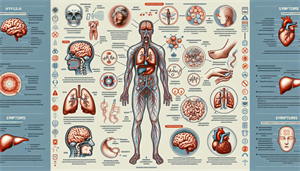
Understanding Low Oxygen Levels
Low oxygen levels, or hypoxia, is a condition where the body or a region of the body is deprived of adequate oxygen supply. It varies from mild to severe, with the typical range for normal blood oxygen level being between 95-100%. Low oxygen levels can trigger a variety of symptoms, such as fatigue, distraction, dizziness, nausea, and breathing difficulty. It’s important to monitor blood oxygen saturation levels as persistent low levels can inflict harm on vital organs and even pose a risk of fatality.
Oxygen saturation can be measured using pulse oximetry, a non-invasive method that uses a small clip on the finger. For a more precise measurement, arterial blood gas analysis can be employed. Oxygen levels can be affected by diseases such as asthma or COVID-19. Moreover, during sleep, natural slowing of breathing can cause oxygen levels to drop, reducing the oxygen transported in the blood.
Common Causes of Low Oxygen While Lying Down
While several factors can cause blood oxygen levels drop while lying down, some of the most common include sleep apnea, heart failure, and chronic obstructive pulmonary disease (COPD). These conditions often lead to disrupted sleep and pose significant health complications.
Sleep Apnea
Sleep apnea, specifically obstructive sleep apnea, is a medical condition characterized by repeated interruptions in breathing during sleep, leading to decreased oxygen levels in the body and excessive daytime drowsiness. This primarily happens due to the relaxation of the muscles in the throat that obstructs the airways, especially when lying on the back.
Individuals suffering from sleep apnea may exhibit symptoms such as snoring, difficulty maintaining sleep, waking up with a dry mouth or sore throat, and experiencing daytime fatigue. The condition results in fragmented sleep and can lead to excessive sleepiness during the day. Treatments may range from simple nasal decongestants to the use of breathing devices such as a mouthpiece or a continuous positive airway pressure (CPAP) machine.
Heart Failure
Heart failure is another condition that can cause low oxygen levels while lying down. It leads to fluid buildup in the lungs, known as pulmonary edema, which results from increased pressure in the heart. This accumulation of fluid can lead to shortness of breath when lying down. Indications of reduced oxygen levels in individuals with heart failure include headache, difficulty breathing, rapid heart rate, bluish skin, nausea, lack of appetite, difficulty concentrating, decreased alertness, and chest pain if heart failure is caused by a heart attack.
The impact of heart failure on oxygen saturation levels is substantial, leading to reduced pulse oxygen saturation and heightened risk of mortality.
Chronic Obstructive Pulmonary Disease (COPD)
Chronic Obstructive Pulmonary Disease (COPD) is a chronic inflammatory lung disease that causes obstructed airflow from the lungs.
Symptoms include breathing difficulty, cough, mucus production, and wheezing. COPD can lead to low oxygen levels while lying down, and it is often associated with other conditions such as heart disease, lung cancer, and high blood pressure.
Management of COPD involves lifestyle changes, medications, and in severe cases, surgery or lung transplant.


